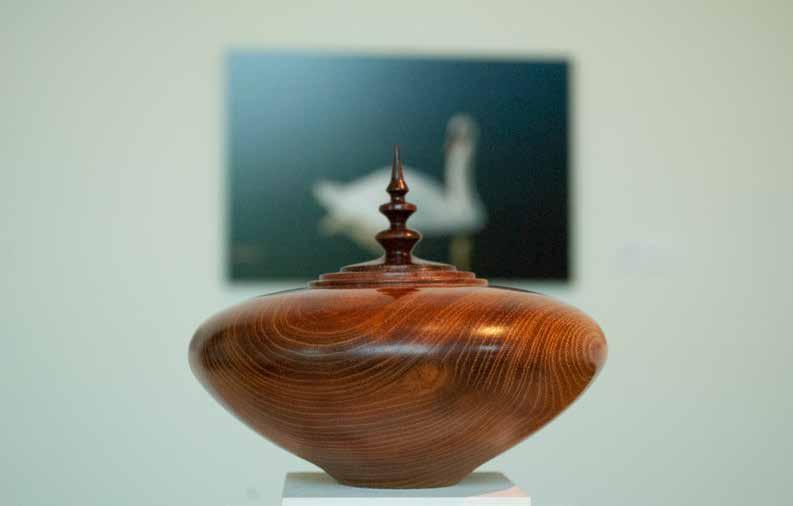
4 minute read
Celebrating a Century of Life: BOB HAWKS
Bob Hawks, Bois d’Arc 7, Bois d’Arc (Osage Orange), 4.5” x 5”

Advertisement
By Zack Reeves
From the moment the visitor walks into Celebrating a Century of Life: Bob Hawks in Tulsa’s 108|Contemporary, they’ll notice a sharp dichotomy at play, almost as if the show was put together by two separate artists. The exhibition is dedicated to two very different types of art: photography and woodturning. The viewer may have trouble making up their mind on which aspect to focus.
Along the walls are mounted prints of photographs spanning multiple decades, styles, and uses. A spare, journalistic shot of sailors standing at attention hangs next to a highly stylized shot of donuts and cider for a cookbook. One wall is dedicated to nature shots—swans, spiders, deserts—while another hosts agricultural shots: a corn planter, a crop duster, a harvester tractor.
Conversely, displayed on podiums throughout the space are wood sculptures: urns, bowls, and platters. These wooden pieces, variously shaped and styled, allow for a more tangible exploration of the gallery, and force the viewer’s eye to consider a very different type of space than the flat photography prints.
The effect of the two styles together, while admittedly a little jarring, speaks to the diversity of scope that Bob Hawks has brought to bear during a long career of both commercial and hobby art-making. Hawks operated a commercial photography business in Tulsa for 40 years, and after retirement, began woodturning as a hobby.
Some of the most interesting photographs to me are those of Tulsa in the late 40s, 50s, and 60s. A surprising shot of a passenger train’s ticket-taker stands out. While the shots of skylines and sprawl depict a world which still exists for present-day Tulsans, Train Depot, Tulsa, 1949 depicts a world in which most Tulsans have never known—passenger trains stopping in Tulsa.
Nurse and Child is by far the most tender of the photographs. A heavily-shadowed backdrop brings forward the two subjects: a child curling into the caress of a nurse, wearing a traditional nurse’s apron and cap, who reads to the child from a book. The affection that emanates from the photo is warm and quiet; we are witnessing, it seems, a private act, a transmission of knowledge from adult to child—though the nurse looks like she is barely an adult herself.
Train Depot, Tulsa, 1949 and Nurse and Child both function nostalgically for the viewer: they point towards the past and we are given to understand that times have indeed changed. Passenger trains no longer stop here. Nurses no longer dress this way. The changing world is a well-trodden subject for Hawks, pointing out new technologies (the Golden Driller, farming equipment) and urban landscapes.
While the photographs are interesting in their own right, it is the stunning wood-turned pieces that are the star of the show. Some are obviously made for potential use, such as the platters and salad bowls. Others, however, are obviously art objects in and of themselves, like the egg-shaped objects whose tops look artfully shattered—large, intricate pieces you couldn’t use in your kitchen if you wanted to.
Standing out all the more among these large works are Hawks’ smaller, more fanciful pieces: a trio of vessels the width of compact discs hold their own kind of intimate space between a platter and a bowl. These delicate pieces could barely hold a helping of soup and yet they’d be an appropriate vessel for one’s ashes to travel in.
One thing I wished for from this show was a little more context: with the exception of a few years in the titles, none of these pieces are dated. And besides an introductory wall text explaining—in two short paragraphs—Hawk’s work in his own words, the viewer is given very little guidance with which to consider the artworks. These considerations aside, however, I really enjoyed spending time inside this peaceful and varied show. While the distinction between the photographs and the sculptures may seem like a disjunction, the overall effect eventually coheres into one of appreciation for a life well-lived with a variety of interests, each one turned into pieces of art by Hawks’ skillful hand. What we see here is not an artist who could not make up his mind, but an artist who made up his mind many times, and followed his interests wherever they led him. Celebrating 100 Years of Life is a charming, respectful, and well-rounded exhibition, worth a visit for anyone interested in what an artist with a variety of artistic talents can accomplish.
Bob Hawks: Celebrating 100 Years of Life runs through October 18. For more information, visit 108contemporary.org. n
Zack Reeves is a writer and poet living on the banks of the Arkansas River in Tulsa, Oklahoma. He received his BA in English from Oklahoma State University and his MFA in Fiction from The New School in Manhattan’s Greenwich Village. To learn more about Zack and his work, visit zackreeves.com.











